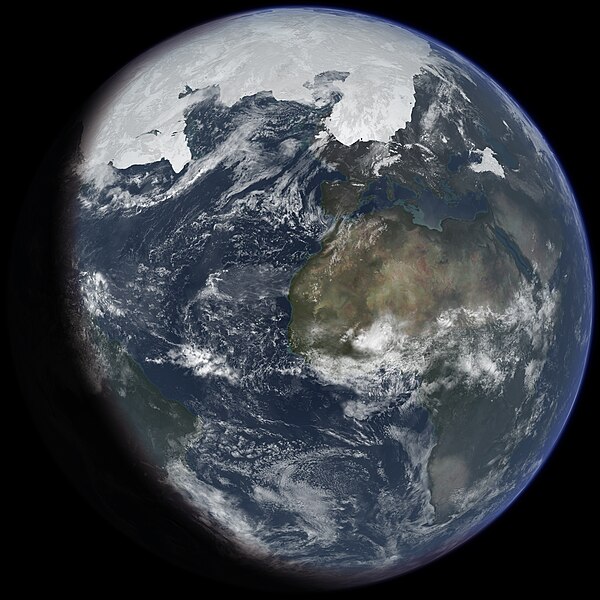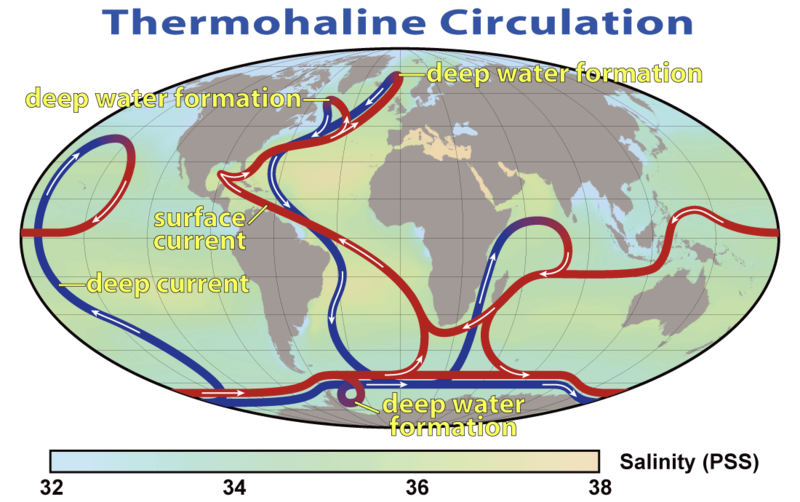Earth's climate is a complicated system, one which climatologists are still studying. Like in a car or computer, a minor change in one component can cause more major effects throughout. Although volcanoes can disrupt this delicate machinery, there are other factors which can plunge Earth into an ice age, some of which built in, others brought about by humans.
History
150 000 years ago, Earth orbited a little further from the Sun than normal. It went through a particularly severe ice age, where the human population dropped to as low as 2000 people.
13 000 years ago, Earth was exiting its latest ice age. Fresh water was collecting in a lake where Hudson Bay is today, dammed by a mass of ice. This dam burst, pouring quadrillions of gallons of fresh water into the northern Atlantic Ocean. As a result, Earth went through a double-dip cooling.
Eccentric orbit
The Earth's orbit around the Sun is not entirely circular, nor is it stable. It goes through a set of three Milankovitch cycles, where:
- The Earth's orbit cycles between a long and short ellipse (eccentricity)
- The Earth's axis (normally 23.5° off vertical) changes its angle from vertical (axial tilt)
- The Earth's axis itself wobbles (precession)
Earth's eccentricity Milankovitch cycle, exaggerated for emphasis.
Of these, the eccentricity cycle impacts Earth's climate the most. When the orbit elongates (that is, its eccentricity increases), Earth hangs further away from the Sun for longer periods of time, allowing less sunlight to reach it. Earth's orbit elongates at its most every 100 000 years, and its climate-changing effects may be reinforced or dampened by the other two cycles.
Snapped conveyor
Earth's great ocean conveyor.
Above the ocean's great currents rules the thermohaline circulation (also known as the great ocean conveyor). While ocean currents circulate surface water in gyres, the great ocean conveyor carries water throughout the world and up and down the depths. When warm water reaches the poles, it cools, becomes denser and sinks. Conversely, cold water from the deep rises as the equatorial sunshine heats it. The Gulf Stream across the North Atlantic forms part of this conveyor belt, bringing with it warmth to the British Isles and continental Europe and warming it above the frozen Canadian landscape at the same latitude.
Given that the great ocean conveyor is a continuous cycle, it need only be disrupted at one point for the whole system to slow down greatly. It would be important to note that seawater's density depends not only on temperature but also salinity; saltier water is denser than fresher water. The water at the poles can then refuse to sink if, somehow, they were diluted.
This can happen where the fresh water ice at the poles melts and dilutes faster than the salt mixes back in. Rapidly melting polar ice happens as a result of the current global warming that Earth is experiencing. When this water refuses to sink, the Gulf Stream, along with the rest of the conveyor, slows down. As a result, the Northern Hemisphere cools significantly. It is by this mechanism that global warming can ironically produce an ice age.
Eye of the storm
Tropical Cyclone Bingiza.
As the Sun heats the Earth's surface, the heat eventually needs to escape back into space. Normally, warm air rises and carries with it heat to the cooler upper atmosphere. Where a large amount of heat accumulates, especially in the ocean, this heat starts powering a tropical cyclone (also known as hurricane, typhoon or simply cyclone).
The Sun's radiance drives not only tropical cyclones but also the rest of the world's weather. Should the world become only mildly warmer, the weather becomes surprisingly more volatile and active.
The Earth's atmosphere provides a greenhouse effect to Earth's surface. It is gases like carbon dioxide and water vapour that absorb and re-radiate heat back to Earth. Due to the burning of fossil fuels, there is an increasing proportion of carbon dioxide in the atmosphere, and it is this phenomenon that is widely believed to be the cause of global warming.
Large amounts of methane, a greenhouse gas much more potent that carbon dioxide, is trapped within polar ice. As this ice melts, it releases that methane back into the atmosphere, warming the Earth further. This is in addition to methane produced from the gut.
Consequences of an ice age
- Mass extinctions
- Crop failure
- Famines
Consequences of global warming (beyond shutdown of thermohaline circulation)
- Deaths induced by heat stroke and hypothermia
- Catastrophic property damage
- Coastal flooding
Conclusions
- 2012-compatible? No
- Will the world end with a bang or a whimper? Whimper
- Armageddon or Ragnarok? Ragnarok in an ice age, Armageddon in a heatwave
Bibliography
- Beedle, Matt (1999), Milankovitch Cycles, viewed 20 May 2011, <http://www.homepage.montana.edu/~geol445/hyperglac/time1/milankov.htm>.
- Dean, Tim (2008), 'Doomsday', Cosmos, no. 22.
- The Human Family Tree (2009), television program, National Geographic Channel.
- Living on Mars (2009), television program, National Geographic Channel.
- Naked Science: Big Freeze (2006), television program, National Geographic Channel.
<< Return to Doomsayer's Guide to Doomsdays




No comments:
Post a Comment